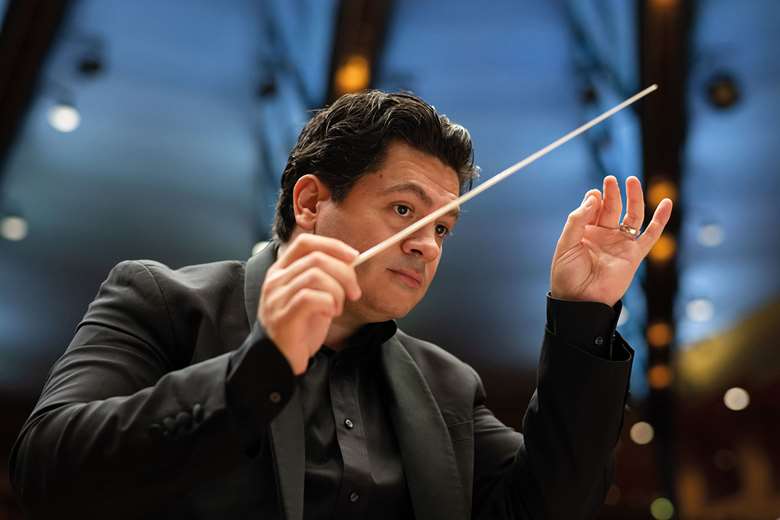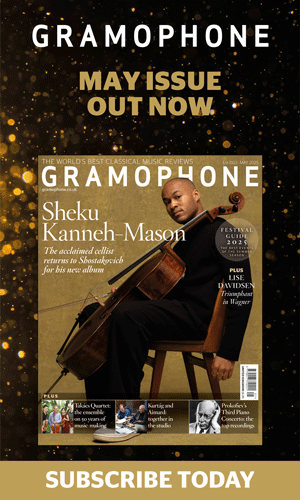Rachmaninov’s Symphony No 3: inside the score with Cristian Măcelaru
Christian Hoskins
Friday, January 24, 2025
Cristian Măcelaru tells Christian Hoskins about the special qualities of this final symphony

When Leopold Stokowski conducted the premiere of Rachmaninov’s Third Symphony with the Philadelphia Orchestra in 1936, almost three decades had passed since the appearance of the Second, and critical and public responses were mixed. There is no doubting Cristian Măcelaru’s enthusiasm for the Third, however. ‘It’s my preferred symphony of the three,’ he immediately tells me. ‘As an assistant conductor in Philadelphia, I studied the symphony, and I really fell in love with it. This was a completely different world that I had not seen before. You understand the language, but at the same time it’s very different from the Second Symphony. It’s probably the symphony that I offer most often to orchestras, because I feel it hasn’t been given enough justice, and I absolutely adore performing it. And every time I’ve taken it to an orchestra, many musicians tell me afterwards that they’ve discovered something quite remarkable.’
‘Rachmaninov forces you to come into the drama and the melancholy, as opposed to the way that Tchaikovsky brings it to you’
Măcelaru considers Rachmaninov’s writing in the symphony to be both very cosmopolitan and surprisingly advanced. ‘At the time, it wasn’t perceived as that at all, but it’s really quite extraordinary how Rachmaninov uses small motifs and chants and develops them in so many ways and in so many forms. I also find the symphony to be extremely lyrical and at the same time both free and improvisatory, which I don’t think is the case with the Second Symphony.
‘I find it fascinating that Rachmaninov moved away from the typical Germanic symphonic form he used in the First and Second Symphonies to a three-part structure in the Third,’ he adds. ‘In some ways, I think he’s making an argument for a five-movement work in the way that the middle movement itself forms a three-part structure with a fast and virtuosic scherzo and a slow movement on either side of it. It’s a beautiful arch. It shows the maturity of a composer who really knows and understands form. One thing that’s also very surprising to me is the coda of the third movement. It’s so brilliantly crafted, and the way that he arrives there is really unexpected. It’s not the typical ending of a finale of a symphony.’
I ask about the optional cuts marked in the score of the symphony. ‘There are many of them,’ he notes. ‘When I was in Philadelphia, I used to spend all my free time in the orchestra library looking at every score that they had. One day, I stumbled across a score of the Third Symphony. It was the one that both Rachmaninov and Eugene Ormandy had used for their studio recordings. It was fascinating, because at the very beginning of it there was a note to say that Ormandy’s handwriting was in blue, indicating all the cuts and little changes that he wanted to make. And in red – very beautiful, thin, noble, incredible penmanship – was Rachmaninov’s handwriting. It’s interesting to see where Rachmaninov disagreed with Ormandy and opened up cuts or changed things. I copied everything and put it in my score, so that I have all their markings and all their indications. For my recording, I’ve gone back to the original as much as possible, as there’s only one place where both of them agreed on eliminating something. And there’s always the question of why a cut is there. Was it so that the music would fit on one side of a 78 record? Yes, that’s why. It’s the same story with The Isle of the Dead, where Rachmaninov cut just enough music so that it fits on one side perfectly.’
In view of his experience with the Philadelphia Orchestra, I ask Măcelaru whether a different interpretative approach is required when performing Rachmaninov’s music with the WDR Symphony Orchestra. ‘Well, the relationship between chief conductor and an orchestra is always a two-way street,’ he explains. ‘Everyone talks about the impact that the conductor has on an orchestra, but I definitely feel that they leave an imprint on me, and I’m very proud of that. The reason why I wanted to do Rachmaninov with the WDR Symphony Orchestra is because the depth of the sound they produce is so profound, and there is a warmth and a gentle flexibility that I absolutely adore. There’s a power in the way that they play that’s really overwhelming. It’s never harsh, it’s never forced, it’s never too much. This sound is shaped greatly by the fact that we perform in what is one of the best concert halls, if not the best concert hall, in Germany: the Philharmonie, Cologne. The hall, like the conductor, will define the sound.’
Reflecting on the orchestra’s style in Russian music, Măcelaru explains, ‘When Semyon Bychkov, who’s a wonderful conductor, was their chief, he did a lot of Tchaikovsky and Shostakovich. I felt I could bring a slight mellowing and a slight melancholy to the sound, which you do not find in a Shostakovich symphony. I think for Rachmaninov, that melancholy comes from the geographical distance from his people that he experienced in his life. I think about the fact that I immigrated to the United States, then to Germany and now to France, and I have never lived in my own country. There is a melancholy in that feeling when you miss something but you don’t really know what you’re missing. I feel that Rachmaninov in his music captures this in a gentler way than Tchaikovsky does. Rachmaninov discovered a kind of musical language that was deep and full of melancholy, and this is what I find very much in the Third Symphony.’
We move on to the subject of the influences on Rachmaninov’s music at this point in his career. ‘For him to write music that is so tonal and direct when everybody else was writing music that was starting to be quite dark – even Vaughan Williams in his Fourth Symphony – is really quite something,’ he says. ‘But I think the influences Rachmaninov had in his life had as much to do with his exposure to the global cultural phenomenon. As a travelling musician, as a highly accomplished pianist, he experienced many different ways of creating and playing music on the different continents. I always think about the great relationship he had with Fritz Kreisler. I discovered in Philadelphia that at one point he took all his parts to Kreisler and asked him to add bowings, which are printed in the music. The Kreisler bowings might not work for a 21st-century orchestra, but they inform a musical style that was close to Rachmaninov’s heart. I try to understand what these bowings represent. As Kreisler was such a great musician, they reflect a musical phrasing that was important and stylistically appropriate. Sometimes they seem bizarre, because we want to play a theme according to our modern understanding. The way that Kreisler would have played it would have been very reserved and in some ways distant, and I think that Rachmaninov identified with this because the drama and the melancholy that I was speaking about earlier is hidden under a veil of distance and elegance. Rachmaninov forces you to come into it, as opposed to the way that Tchaikovsky brings it to you.
‘It took me a long time to understand the way that Rachmaninov interprets his own music, and why it feels much faster than what we do these days. I think it’s this approach of not wallowing in something that is beautiful, not turning it into a melodrama rather than a melancholic point of view. I’ve studied the symphonies for much of my life, but in my mature years, I’ve started really trying to understand Rachmaninov’s point of view. I feel that sometimes composers are grateful for someone performing their music, and will acquiesce and accept compromises, even though what they wrote on paper is probably what they actually wanted. I therefore feel that my job as an artist is to come as close as possible to what the composer left in the score, and I hope I do it justice.’







